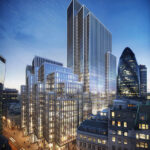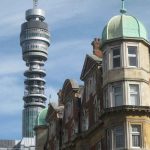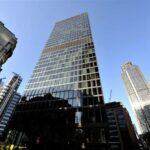ArcelorMittal Orbit, Anish Kapoor Project, Olympic Park Landmark Design, Cecil Balmond
Olympic Park Landmark, London
ArcelorMittal Orbit, England, UK – design by Anish Kapoor with Cecil Balmond / Arup
11 Aug 2012
ArcelorMittal Orbit
Lighting The ArcelorMittal Orbit
Glamming the 2012 Games with Event Lighting whilst Looking after the Environment and River Corridor Ecology
The ArcelorMittal Orbit is the first public artwork by Anish Kapoor to be lit. Arup’s lighting team has worked closely with Kapoor and Cecil Balmond to create a lighting scheme that will highlight the sculpture’s complex geometric form.
Olympic Park Landmark:
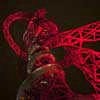

Olympic Park Landmark photographs : Thomas Graham, Arup
The feature lighting scheme encourages visitors into the Park and the ArcelorMittal Orbit by creating a “must see” element to the sculpture at night. The scheme will play an integral part in the lighting and atmosphere of the Olympic Games with the Olympic Park Landmark lit up in a variety of modes for different events and times of day. Beyond The Games, visitors will also experience the metaphor of an orbit after dark; using light to unravel the sculpture’s convoluted form and to grasp its dynamic shape. Arup Lighting Director Florence Lam refers to their approach as using “dark light”.
Sustainability has been a critical factor in Arup’s thinking. Arup Lighting’s choice of saturated red LED (light emitting diode) lighting accentuates the bespoke red specified by Kapoor for the sculpture.
The Olympic Park Landmark lighting scheme achieves maximum theatrical visual impact yet consumes less energy than white light. LEDs emit zero UV light, which would otherwise disturb wild-life in the vicinity, for example, moths and bats. Arup’s lighting designers, structural engineers and the architects collaborated closely to ensure that the light projectors are all discreetly located within the structure and carefully focused and aimed to minimise light spill onto the ecologically sensitive area of the river corridor and limit sky glow.
Sophisticated lighting software, RADIANCE, was employed to analyse and predict the lighting distribution over the sculpture and its surroundings to ensure full compliance with the ODA lighting strategy.
Arup’s Electrical and Mechanical Engineers worked with the firm’s lighting designers to integrate all services in a way that has ensured that all cables and wirings are invisible.
The result is a cohesive, energy efficient and aesthetically attuned lighting project demonstrating how artists and engineers can collaborate creatively and effectively on major, and challenging artworks in public spaces.
14 Jun 2012
ArcelorMittal Orbit London
Ushida Findlay Architects & the ArcelorMittal Orbit
Ushida Findlay Architects is the ArcelorMittal Orbit’s official delivery architect, responsible for turning one of the world’s tallest sculptures into a ‘habitable building’, a remarkable observation tower.
Olympic Park Landmark in East London:
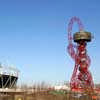
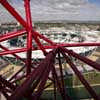

Olympic Park Landmark images from London Legacy Development Corporation
Kathryn Findlay on their role in building the Orbit
Creating the ArcelorMittal Orbit has been a thrilling helter-skelter ride. Standing at 114.5m high, it is a large building, as well as a sculpture. Ushida Findlay Architects’ role as the delivery architects has been to work with the joint vision of the artist Anish Kapoor and the engineer and co-creator Cecil Balmond.
From the initial sketch it has grown into a looping lattice form. The lattice evolved from the need to build the vision and make the concept constructible. Kapoor and Balmond’s idea was to ‘challenge the idea of tower’, so initially it was just a vertical form. It is stabilized by points crossing in space on a tripod base. Daniel Bosia of Arup engineered the overall form and we were appointed as the delivery team.
We are always asked what architecture there is in the ArcelorMittal Orbit. The answer is that as well as it being a large engineered structure and an artistic expression, it is also a complex feat of architecture. We had to devise the parts people will inhabit such as the entry pavilion, the lift shaft, the observation decks, the emergency stair and the plant (machine) screens, as well as coordinate all of the junctions between the big red bits of steelwork. All of these junctions were wild, unpredictable shapes coming at each other in all directions. These clashes were heaven and hell to work out.
The precision structure required precision geometry. We wanted to minimise parts that detracted from the journey through this three-dimensional maze. We feel that this process has made the vision more convincing as a piece of art.
In reality, up close, the design creates a monumental form and a new type of space as well as a unique human experience. The nitty gritty detail was exceptionally hard work to think through, a hundred times more consuming that we had imagined. At each stage there was a complex problem which needed solving. Now it is done we feel that is a massive achievement. It’s going to become a symbol of our ever-evolving city, where new architectural typologies can come to fruition. What will come next?
1 Jun 2012
The Orbit Construction News
ArcelorMittal Orbit unveiled to the world
Main construction of the London 2012 landmark is declared complete ArcelorMittal, tier two sponsor of the London 2012 Olympic and Paralympic Games and the world’s leading steel company, will today offer a preview of the completed ArcelorMittal Orbit – the 114.5 metre sculpture designed by Anish Kapoor and Cecil Balmond which will stand at the heart of the Olympic Park.
Olympic Park Landmark:
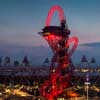
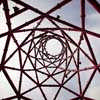

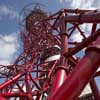
Olympic Park Landmark images from London Legacy Development Corporation
The ArcelorMittal Orbit is being handed over to the London Legacy Development Corporation later this month, so that Balfour Beatty Workplace can complete the fit-out ahead of the London 2012 Games where it will be a ticketed visitor attraction.
The press event was attended by the team behind the sculpture, including Anish Kapoor and Cecil Balmond, Lakshmi N. Mittal, Chairman and CEO, ArcelorMittal, and Mayor of London, Boris Johnson, alongside the architects, engineers and builders who have helped bring the project to reality. For the first time, attendees to the unveiling will be able to travel up to the viewing platform and enjoy a panoramic view of up to 20 miles, encompassing the entire Olympic Park and London’s skyline beyond. At 114.5m, the ArcelorMittal Orbit is the UK’s tallest sculpture and stands 22 metres taller than New York City’s Statue of Liberty.
“It gives me great pride to see the ArcelorMittal Orbit standing not only as a completed work of public art but as a physical symbol of the Olympic spirit,” comments Lakshmi N. Mittal, Chairman and CEO of ArcelorMittal. “It makes me very proud that ArcelorMittal plants from across the world contributed to this showcase of the strength and versatility of steel,” he adds.
Boris Johnson:
“This 114.5metre-high attraction to trump rivals the world over is a calling card for investment in east London. It is a symbol of prosperity and growth, backed by one of the world’s most astute business leaders, which delivers the strongest message that this part of London is open for business after decades of neglect. “In addition to the £11billion plus investment that has taken place around the Olympics over the last four years, the ArcelorMittal Orbit will draw visitors to newly regenerated swathes of east London in perpetuity and has changed our skyline and aspirations forever. The development of this area, creating new jobs, homes, schools, and thriving communities beyond the Olympics, is one of the most important regeneration priorities as we lay the ground now to meet the needs of the next 25 years.”
Anish Kapoor:
“I am absolutely delighted that construction is now complete and I would like to thank the project team for making this possible and for their work on what is technically a very challenging project. I am looking forward to the Olympics when visitors to the Park will be able to go up the ArcelorMittal Orbit for the first time and I am delighted that members of the public will be able to interact with the work in this way.”
Cecil Balmond:
“Anish and I were conscious from the beginning that the ArcelorMittal Orbit would be a lasting legacy to the city and so we wanted to stretch the language of the icon as far we could go. The Orbit is a hybrid, a network of art and structure, and its dynamic is the non-linear. You read into it multiple narratives in space.”
Olympic Park Landmark:
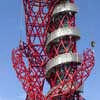

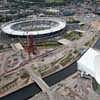
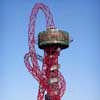
images from London Legacy Development Corporation
One of the world’s leading artists, Turner Prize winning Anish Kapoor studied in London, where he is now based. He is well known for his use of rich pigment and imposing, yet popular works, such as Marsyas, which filled the Tate’s Turbine Hall as part of the Unilever Series, Cloud Gate in Chicago’s Millennium Park and his recent record breaking show at the Royal Academy, the most successful exhibition ever presented by a contemporary artist in London.
The ArcelorMittal Orbit was designed by Anish Kapoor and one of the world’s leading structural designers, Cecil Balmond, who trained and lives in London, and is known for his innovative work on some of the greatest contemporary buildings in the world, such as the CCTV building in Beijing, as well as many Serpentine Gallery Pavilion commissions.
Construction of the ArcelorMittal Orbit took 18 months and required 560 metres of tubular red steel to form the sculpture’s lattice superstructure. The result is a bold statement of public art that is both permanent and sustainable, with close to 60 per cent of the 2,000 tonnes of steel used in the sculpture being drawn from recycled sources, underlining steel’s status as the world’s most recyclable material. Steel was chosen for the ArcelorMittal Orbit because of its unique properties including strength, modular structure and advantages of weight and speed of construction.
Sitting between the Stadium and the Aquatics Centre, the ArcelorMittal Orbit will be a beacon of the Olympic Park during the Games and the Queen Elizabeth Olympic Park as the area will be known after the Games.
Visitors will be able to take a trip to the top of the structure in a lift and down too if they wish, although they will be encouraged to walk down the spiral staircase, which has 455 steps and has been designed to enable the guests to experience the feeling that they are orbiting around the structure as they descend it.
After the Olympic and Paralympic Games and following a period of transformation, the Legacy Corporation will run the ArcelorMittal Orbit as a visitor attraction with ticketed viewing from the observation decks and a compelling venue for private functions. It will be able to accommodate around 5,000 visitors a day with potential to attract around one million people during its first year of operation. It will have the capacity to accommodate between 400 – 600 visitors per hour, including full wheelchair access.
Last month, the Legacy Corporation announced that the ArcelorMittal Orbit will light up East London after 250 colour spot lights were added to the sculpture. Each can be individually controlled to produce a stunning digital combination of static and animated effects including a 15 minute moving light show every evening after the Games.
Andrew Altman, Chief Executive of the London Legacy Development Corporation, said: “The ArcelorMittal Orbit will become one of London’s most spectacular visitor attractions and a stunning backdrop to the Queen Elizabeth Olympic Park. Not only will it offer differing views by day and night, but it will light up the East London skyline to become a beacon of the incredible transformation of this part of East London.”
The Legacy Corporation, which will lease the ArcelorMittal Orbit to LOCOG during the Games, has said that 85% of the 50 jobs created in the venue after the Games will go to local people.
As a tier two sponsor of London 2012, ArcelorMittal has committed to funding up to £19.6 million of the £22.7 million cost of the ArcelorMittal Orbit, with the outstanding £3.1 million provided by the London Development Agency. It has been estimated that the resulting visitor attraction will generate up to £10 million of revenue per annum and create up to 50 new jobs following the 2012 Olympic and Paralympic Games.
25 Nov 2011
The Orbit – Construction
ArcelorMittal Orbit – photo of progress on the Olympic Park Landmark:

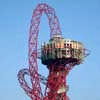
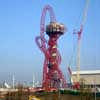
images from Wrightstyle
Wrightstyle in London Olympic Team
A UK company that supplies its specialist systems worldwide is completing two prestigious contracts for the Olympic Games in London next year.
Wrightstyle Limited’s glass and steel glazing systems are designed to protect buildings against a range of threats, most commonly fire, with recent overseas contracts in the Lebanon, United Arab Emirates, Malta and the USA.
The Devizes-based company is supplying fire-rated and acoustic door and curtain wall systems for the VIP concourse area of the Olympic main stadium, and curtain walling and fire-rated unlatched doors for the ArcelorMittal Orbit, the 115 metre high observation tower under construction in the Olympic Park.
The complex structure, which will be the UK’s largest piece of public art, will allow visitors to view the whole area from two observation platforms and is expected to be completed by the end of this year.
The Orbit is a key component in legacy planning for the Olympic Park and for the regeneration of the wider area.
Wrightstyle was also involved on legacy planning for the last Olympic Games in Athens, helping to transform its 41,000 sq metre media hub into one of Greece’s foremost retail centres.
The company’s systems can also be found in the 70,000-seat Moses Mabhida Stadium in Durban, South Africa, built as a venue for the 2010 FIFA World Cup. Wrightstyle also supplied to the 2006 Doha Asian Games.
Wrightstyle’s fire, ballistic and blast systems have also recently been installed in the Dubai Metro and the nationally-important US Marines Chapel in Virginia. The company is also currently involved in a major regenerative project in Beirut, the Lebanese capital.
“Steel glazing systems are an important component in modern architecture, combining the inherent strength of steel with transparency that only glass can provide,” said Kim Kempster, Wrightstyle’s managing director.
“However, building in fire protection, or protection against other threats, has become a highly specialist business – and one for which we are recognised worldwide. We are extremely pleased to be working on projects for the London games,” he said.
www.wrightstyle.co.uk
27 Jul 2011
ArcelorMittal Orbit – photo of progress on the Olympic Park Landmark:
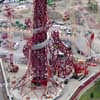
image from ODA
6 Jul 2011
ArcelorMittal Orbit – Criticism
Nicholas Grimshaw criticises ArcelorMittal Orbit as a missed opportunity, reports BD. The celebrated British architect claims the tower could have been a “great symbol”.
ArcelorMittal Orbit – designed by Anish Kapoor with Cecil Balmond/Arup

image : Arup
Indeed there has been surprise since the design was unveiled at its tackiness. e-architect ask what does the structure say about the UK? what does it say about the Olympics? These questions would be less potent if at least the structure was beautiful, elegant or refined. A surprising aspect of the situation is that Anish Kapoor and Cecil Balmond (not to mention Arup of course) have built up a strong pedigree in beautiful, elegant and refined structures.
23 Jul 2010
ArcelorMittal Orbit – Planning Approval
Newham Council approve planning application for this bizarre sculpture. The ODA have yet to approve but that is likely to be a formality.
Anish Kapoor has a strong reputation built up from a series of very potent sculpture that are often engaged with the architecture around them (eg Baltic Mills or Tate Modern works) but this design is undermined by the concept, it looks twee and messianic in the same breath. Adrian Welch, e-architect editor.
31 Mar 2010
Anish Kapoor to design iconic visitor attraction for Olympic Park
The ArcelorMittal Orbit set to become UK’s largest sculpture
The Mayor of London Boris Johnson and Lakshmi Mittal, Chairman and CEO of ArcelorMittal, today unveiled the artist and design chosen to create a spectacular new visitor attraction in the Olympic Park.
Award winning London-based artist Anish Kapoor has been given the commission of a lifetime to design the spectacular new public attraction in the Olympic Park. The stunning artwork, to be entitled ‘The ArcelorMittal Orbit’, will ensure the Park remains an unrivalled visitor destination following the 2012 Games, providing the key Olympic legacy Mayor of London Boris Johnson envisaged for the East End.
The breathtaking sculpture – thought to be the tallest in the UK – will consist of a continuous looping lattice of tubular steel. Standing at a gigantic 115m, it will be 22m taller than the Statue of Liberty in New York and offer unparalleled views of the entire 250 acres of the Olympic Park and London’s skyline from a special viewing platform. Visitors will be able to take a trip up the statuesque structure in a huge lift and will have the option of walking down the spiralling staircase.
One of the world’s most distinguished contemporary artists, Turner Prize winning Anish Kapoor studied in London, where he is now based. He is well known for his use of rich pigment and imposing, yet popular works, such as the vast, fleshy and trumpet-like Marsyas, which filled the Tate’s Turbine Hall as part of the Unilever Series, the giant reflecting, pod like sculpture Cloud Gate in Chicago’s Millennium Park and his recent record breaking show at the Royal Academy, the most successful exhibition ever presented by a contemporary artist in London.
Anish Kapoor’s proposal has been developed in collaboration with one of the world’s leading structural designers, Cecil Balmond of Arup. Balmond, who trained and lives in London, is known for his innovative work on some of the greatest contemporary buildings in the world, such as the CCTV building in Beijing, as well as numerous Serpentine Gallery pavilion commissions. The two began working together on the Marsyas project in 2002 and have become renowned for their ambitious, large-scale public art projects.
ArcelorMittal will fund up to £16million of the £19.1million project with the outstanding £3.1 million provided by the London Development Agency. The unveiling also marks ArcelorMittal’s announcement to become a tier two sponsor of the Olympic and Paralympic Games, to support the infrastructure and success of 2012.)
The Mayor of London Boris Johnson and the Olympics Minister Tessa Jowell agreed the commission in partnership with Mr Mittal after bringing together a panel from the art and design world to advise on a long list of proposals.
Anish Kapoor’s team made an outstanding proposal that would be accessible and leave a fitting 2012 legacy. Anish Kapoor said: ‘I am deeply honoured to be invited to undertake this challenging commission. I am particularly attracted to it because of the opportunity to involve members of the public in a particularly close and personal way. It is the commission of a lifetime.’
London Mayor Boris Johnson said: ”Long after the Games are over our aim is to have a stunning spectacle in east London that will be recognised around the world. I’m thrilled that when visitors from every corner of the globe plan trips to our must see attractions they will now eagerly include the ArcelorMittal Orbit! It will be an internationally acclaimed family attraction and I would like to thank Mr Mittal for his generous support. Anish Kapoor’s inspired art work will truly encapsulate the energy and spirit of London during the Games and as such will become the perfect iconic cultural legacy.”
Lakshmi Mittal, CEO of ArcelorMittal, commented: “The Olympic Games are one of the few truly iconic global events. I was immediately excited by the prospect of ArcelorMittal becoming involved because ArcelorMittal is a global company with operations in more than 60 countries. And as someone who lives in this great city, I remember the great excitement felt when it was announced that London had been selected to host the 2012 Olympic and Paralympic Games. We set out to create a transformational piece of art that will be an iconic symbol for the Olympics and also a new landmark that will endure long after the Games themselves. Everyone at ArcelorMittal is delighted with the outcome of the ArcelorMittal Orbit. London will have a bold, beautiful and magnificent sculpture that also showcases the great versatility of steel.”
The attraction will stand in the southern part of the Olympic Park between the Stadium and Aquatics Centre and will open in time for the 2012 Games. After completion, the Olympic Park Legacy Company will take ownership and run the visitor attraction.
Minister for the Olympics and London Tessa Jowell said: “This stunning structure will become a new iconic London landmark towering 115 metres into the London skyline. Alongside the Olympic Stadium and Aquatics Centre, Anish Kapoor’s brilliant design will be like to honey to bees for the millions of tourists that visit London each year. Having been involved in this project from the outset, I’m now looking forward to seeing it go from a great idea into a brilliant reality.”
Chairman of the London Organising Committee of the Olympic Games and Paralympic Games (LOCOG), Seb Coe said: “Our ambitions for the Games are very clear and very simple. We want to leave leaving a lasting legacy: of more young people playing sport, of changing public attitudes towards disabilities through the Paralympic Games, of an extraordinarily transformed landscape in East London, in which this impressive sculpture will play a central role. The new sculpture will be an indelible memory, a declaration of legacy and a definable landmark that Londoners and people from around the world will enjoy visiting during the Games and long afterwards.
Margaret Ford, Chairman of the Olympic Park Legacy Company, said: “When you are able to combine an industry leader with a world renowned artist, supported by significant investment, we clearly see the significance of the Olympic Park. This visitor attraction will sit alongside our other iconic venues and, in animating the site, will encourage the public to use the park. This is a magnificent legacy asset.”
Advisory panel members Julia Peyton-Jones and Hans Ulrich Obrist of the Serpentine Gallery, said: “The success of Anish Kapoor’s Marsyas commission Tate Modern in 2003 and his exhibition at the Royal Academy in 2009 demonstrates that his work already strikes a chord with many people. His close partnership with the distinguished engineer Cecil Balmond has created the exciting prospect of a sculpture to be climbed, an unexpected view of the city and a new place to visit and enjoy in London.”
Tate Director Sir Nicholas Serota, who sat on the advisory panel, said: “We are delighted that Anish Kapoor with Cecil Balmond will give London a new structure which is one of the most exciting new commissions of our time. The collaboration between Anish Kapoor, Cecil Balmond and Lakshmi Mittal bridges art, architecture, engineering and business to produce a new landmark for London.”
ArcelorMittal Orbit compared to other landmark structures / sculptures
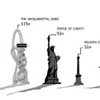
image © Hayes Davidson
Helter Skelter Orbit Olympic Park Slide – 4 Mar 2016
Location: Stratford, London, England, UK
London Buildings
Contemporary London Building Designs
London Architecture Links – chronological list
London Architecture Tours by e-architect
Anish Kapoor
Anish Kapoor artist
Anish Kapoor is one of the most influential sculptors of his generation. Born in Bombay in 1954, he has lived and worked in London since the early 70s. Over the past twenty years he has exhibited extensively in London and all over the world. His solo exhibitions have included Kunsthalle Basel, Tate Gallery and Hayward Gallery in London, Reina Sofia in Madrid, CAPC in Bordeaux, Haus der Kunst in Munich and most recently, MAK in Vienna.
He has also participated internationally in many group shows including the Whitechapel Art Gallery, the Royal Academy and Serpentine Gallery in London, Documenta IX in Kassel, Moderna Museet in Stockholm and Jeu de Paume and Centre Georges Pompidou in Paris. He represented Britain in the Paris Biennale in 1982, and again in 1990 at the Venice Biennale, for which he was awarded Premio Duemila. The following year he won the prestigious Turner Prize.
He recently acted as Guest Artistic Director of the Brighton Festival 2009. He was elected Royal Academician in 1999 and he has been awarded Honorary Fellowships by the London Institute and Leeds University (1997), University of Wolverhampton (1999) and the Royal Institute of British Architects (2001). His recent major solo exhibition at the Royal Academy of Arts in London (September-December 2010), showcasing a number of new and previously unseen works, attracted more than 260,000 visitors in three months.
ArcelorMittal Orbit – Further Information
The advisory panel, backed by the Mayor and the Olympics Minister, brought together highly regarded figures with expertise, experience and knowledge of the art and design sectors, as well as key personnel from the Olympic Delivery Authority: Nick Serota (Tate), Julia Peyton-Jones (Serpentine Gallery), Hans Ulrich-Obrist (Serpentine Gallery), Sarah Weir (ODA), Stuart Lipton (Chelsfield), Anita Zabludowicz (176 Zabludowicz collection), Michael Morris and James Lingwood (ArtAngel) and Munira Mirza (Mayoral Advisor on Arts and Culture).
The Funding for the Orbit consists of a £10 million cash donation and £6 million in underwriting of capital costs which could be potentially recovered from post games profits.
The construction of the attraction will be subject to planning consent.
The focus of the London 2012 Games will be the Olympic Park in east London, which will house the new sport venues and is located in the Lower Lea Valley – an area of great untapped potential. After the Games the area will be transformed into the largest urban park created in Europe for more than 150 years. www.london2012.com/plans/olympicpark/index.php
The Mayor of London published Cultural Metropolis last year, which sets out his initial vision for the visual and performing arts, museums, galleries, archives, libraries, crafts, music and arts provision, the creative industries, heritage and tourism. To download a copy: www.london.gov.uk/mayor/culture/cultural-metropolis.
Anish Kapoor installation, Paris
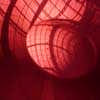
photograph © Karavan
Anish Kapoor : ‘Leviathan’, Grand Palais
About ArcelorMittal
ArcelorMittal is the world’s leading steel company, with operations in more than 60 countries.
ArcelorMittal is the leader in all major global steel markets, including automotive, construction, household appliances and packaging, with leading R&D and technology, as well as sizeable captive supplies of raw materials and outstanding distribution networks. With an industrial presence in over 20 countries spanning four continents, the Company covers all of the key steel markets, from emerging to mature.
Through its core values of Sustainability, Quality and Leadership, ArcelorMittal commits to operating in a responsible way with respect to the health, safety and wellbeing of its employees, contractors and the communities in which it operates. It is also committed to the sustainable management of the environment and of finite resources. ArcelorMittal recognises that it has a significant responsibility to tackle the global climate change challenge; it takes a leading role in the industry’s efforts to develop breakthrough steelmaking technologies and is actively researching and developing steel-based technologies and solutions that contribute to combat climate change.
In 2009, ArcelorMittal had revenues of $65.1 billion and crude steel production of 73.2 million tonnes, representing approximately 8 per cent of world steel output. ArcelorMittal is listed on the stock exchanges of New York (MT), Amsterdam (MT), Paris (MT), Brussels (MT), Luxembourg (MT) and on the Spanish stock exchanges of Barcelona, Bilbao, Madrid and Valencia (MTS). For more information about ArcelorMittal visit: www.arcelormittal.com
Monte S Angelo Metro entrances + tunnel link, Naples, Italy
2003-11
Amanda Levete Architects + Anish Kapoor
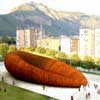
image from architects
Monte S Angelo Metro Building
London Architecture
London Eye
Marks Barfield
Tate Modern Extension
Herzog & de Meuron Architects
Victoria & Albert Museum Jewellery Gallery
Eva Jiricna Architects
Comments / photos for the ArcelorMittal Orbit London – Olympics Park Landmark page welcome
Website: London

